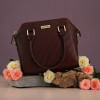80% of leather goods and footwear exports going to just 10 countries

Bangladesh's export earnings from leather goods and footwear are concentrated in 10 countries, with these markets buying roughly 80 percent of the total shipments from the nation in the fiscal year 2022-23.
Industry stakeholders shared the information at a discussion yesterday, highlighting the urgency for market diversification to reduce the risk of export losses stemming from a decline in demand in these markets. Doing so would also create scope for exporters to explore new markets and grow.
At the same time, they also urged Bangladesh's businesses to adopt strategies to improve market access and increase export competitiveness.
"The biggest advantage for Bangladesh is the availability of manpower and raw materials. So, Bangladesh can use this to find new markets and expand its export basket," Lien Chun Yao, managing director of Blue Ocean Footwear Limited, said at a seminar held on the sidelines of the 4th Bangladesh Leather Footwear & Leathergoods International Sourcing Show 2023 at the International Convention City Bashundhara in Dhaka.
The three-day expo, jointly organised by the Ministry of Commerce and the Leather Goods and Footwear Manufacturers and Exporters Association of Bangladesh (LFMEAB), concluded yesterday.
Chun Yao said Bangladesh should join the global value chain. "Leather is one of the most prospective industries in Bangladesh. It has enough scope for both vertical and horizontal expansion in terms of economic return," he added.
Abdur Rahim Khan, additional secretary for the trade support measures wing of the Ministry of Commerce, said, given the circumstances, Bangladesh has to find new markets to be more competitive.
Bangladesh as a least developed country (LDC) is now enjoying duty-free market access or reduced tariff rate facilities while exporting to various developed and developing countries in the world.
"But after LDC graduation we may face some challenges. For this, one instrument is going for a bilateral trade agreement with the country where we think our exports have the best possibilities," he said.
Bangladesh has already identified 12 to 14 countries and work is underway on how to establish bilateral trade with these countries, he informed.
"Unless you have foreign direct investment in the leather sector, there are two things missing. One is capital and the other is technology. That is why the government has taken some initiatives for market expansion and product development," he added.
In future, with LDC graduation in mind, they are going to identify specific countries which can broaden the market, not in terms of diversification but in terms of deepening the market, he added.
Michael Roy, president of the Manufacturing and Operations of Advanced Manufacturing Group, said political stability in Bangladesh over the past few years made it very easy to do business and helped the sector move forward.
He said the main appeal of the leather industry in Bangladesh is the ample supply of raw materials. Other than that, low costs, availability of skilled labour, product quality and infrastructure help Bangladesh compete in the leather product export market, he added.
Amrita Makin Islam, director of the LFMEAB and deputy managing director for Picard Bangladesh Limited, moderated the discussion.

 For all latest news, follow The Daily Star's Google News channel.
For all latest news, follow The Daily Star's Google News channel. 







Comments